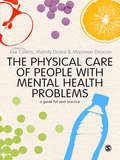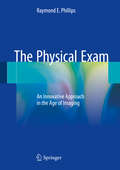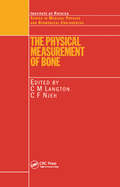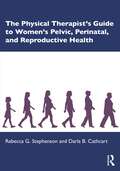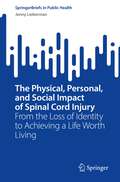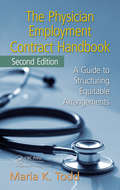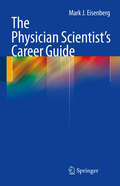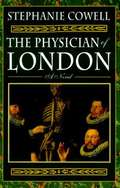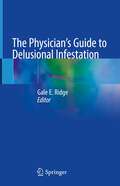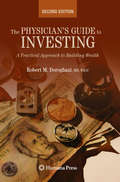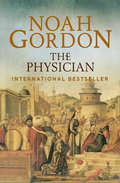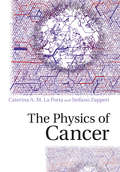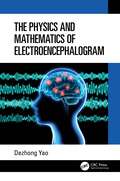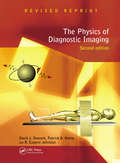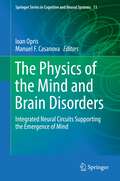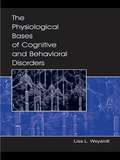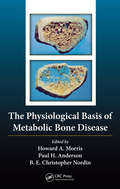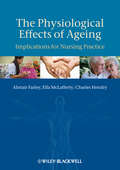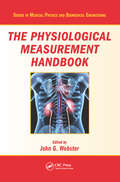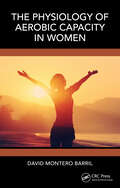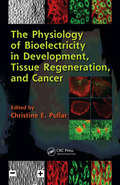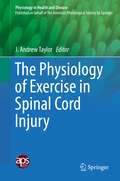- Table View
- List View
The Physical Care of People with Mental Health Problems: A Guide For Best Practice
by Mandy Drake Eve Collins Maureen DeaconThis accessible, practical text provides mental health practitioners with the core knowledge and skills they need to be able to care effectively for the physical health of those who have been diagnosed with mental illness. Linked closely to professional standards, and with a clear values- and evidence-base, the book aims to raise awareness of the physical health needs of individuals with mental health problems, outline the physical health assessment process and suggest health enhancing interventions for use in clinical practice. Consideration will be given to the following aspects of physical wellbeing; - cardiovascular health - diabetes - sexual health - respiratory health - cancer - wound care - substance misuse - infection control - medicine management Further chapters on legal and ethical issues explain the need to practise appropriately within the Mental Health Act and the Mental Capacity Act, while a linking theme throughout the book stresses the importance of health promotion. Backed up by case examples and with a range of reflective exercises throughout, The Physical Care of People with Mental Health Problems is a key text for students and practitioners working in mental health services. It will also be useful reading for practice nurses, district nurses, midwives and all allied health practitioners.
The Physical Exam
by Raymond E. PhillipsThis book invites clinicians to take a fresh look at the routine physical examination by outlining in detail how they can adapt a more efficient, regional approach to the exam activity. By adopting the systematic sequence and focus provided in this novel title, clinicians can offer a more modern physical examination, one that may prove more productive than the methods taught in the pre-imaging era. The Physical Exam: An Innovative Approach in the Age of Imaging offers a unique, step-by-step sequence for the physical exam. The text guides the clinician through a series of steps that involve observing, touching and listening - in an organized sequence, region by region - of all organ systems. The general approach is applicable to every physical examination and can be modified when appropriate. Express pathways are provided so that the clinicians can quickly assess the general health of the patient while focusing on the presenting problem. A major contribution to the diagnostic literature, the book offers a format and level of complexity that will be of significant value to internal medicine and family physicians, emergency professionals, nurse practitioners, physician's assistants, and medical students.
The Physical Measurement of Bone
by C. M. Langton C. F. NjehBone is a complex biological material that consists of both an inorganic and organic phase, which undergoes continuous dynamic biological processes within the body. This complex structure and the need to acquire accurate data have resulted in a wide variety of methods applied in the physical analysis of bone in vivo and in vitro. Each method has it
The Physical Therapist’s Guide to Women's Pelvic, Perinatal, and Reproductive Health
by Rebecca G. Stephenson Darla B. CathcartThe Physical Therapist’s Guide to Women’s Pelvic, Perinatal, and Reproductive Health provides physical rehabilitation throughout the lifespan for women and focuses on pelvic, pregnancy, and reproductive conditions in women. This book combines scientific evidence and clinical experience to help inform practice. It includes the history and evolution of physical therapy in women's health to specific therapeutic practice.The first section provides foundations for the next sections. The second and third sections explore the role of physical therapy in pelvic health and in reproductive health. Each topic is written in an accessible manner with tables, is fully illustrated, and provides a comprehensive review.The Physical Therapist’s Guide to Women’s Pelvic, Perinatal, and Reproductive Health is key reading for physical therapists, midwives, obstetrician (OBs), medical doctors (MDs), birth workers, and allied health professionals.
The Physical, Personal, and Social Impact of Spinal Cord Injury: From the Loss of Identity to Achieving a Life Worth Living (SpringerBriefs in Public Health)
by Jenny LiebermanThis compact book uniquely examines individual lived experience with spinal cord injury (SCI). It provides education and a clearer understanding of the many facets of a SCI -- medical, physical, psychological, cognitive, personal, and social -- in a single compact volume, so that readers learn the effect a SCI can have on a person. The contents also include resources for more specific exploration of information. SCI is a direct public health concern due to not only the cause of the injury itself, most often of violent origin, but also how the individuals perceive themselves after the injury and their participation in society, as well as how society welcomes them back. This compact book has four distinct chapters, each one addressing a different component of SCI with a set of resources to guide the individual with SCI, their family and their friends in the process. It first explores the physical as a means to provide an understanding of what body changes occur. From there, it goes on to examine what is the subjective meaning and lived experience of disability for persons with SCI. The brief ends with an examination of what organizations and programs exist to promote independence and a sense of community for persons with SCI.The Physical, Personal, and Social Impact of Spinal Cord Injury: From the Loss of Identity to Achieving a Life Worth Living is a book with broad appeal. It is written in such a way that it serves as a useful and accessible resource for people who work with persons with SCI, students and instructors with an interest in the subject, as well as persons with SCI themselves and their families.
The Physician Employment Contract Handbook: A Guide to Structuring Equitable Arrangements
by Maria K. ToddThis book provides sample physician employment contracts and explains how each contract works. It is helpful for physicians and administrators who wish to prepare themselves for the contract and employment decisions that lie ahead of them.
The Physician Scientist's Career Guide
by Mark J. EisenbergThe Physician Scientist's Career Guide provides a complete guide to having a successful career as a Physician Scientist. Filled with first-hand experiences and practical advice, it guides readers through each step of this career path, from choosing a degree and training program, to navigating the tenure track, and through the intricacies of applying for and obtaining funding. The volume is unique in that it provides an overview of this entire career path, allowing readers to envision and prepare for their futures. The Physician Scientist's Career Guide fulfills a unique and crucial need and will be an invaluable guide for medical students, fellows and newly appointed faculty members interested in a career in research.
The Physician of London: The Second Part of the Seventeenth-Century Trilogy of Nicholas Cooke
by Stephanie CowellSet in London of the early seventeenth century, this is the second book of the acclaimed trilogy about the physician and priest Nicholas Cooke.
The Physician's Guide to Delusional Infestation
by Gale E. RidgeThis unique, ground-breaking book is a comprehensive clinical guide to the psychiatric disorder of Delusional Infestation (DI). DI is a psychiatric illness characterized by patients holding a monothematic fixed belief of infestations on their skin, body, or immediate environment - a belief that is not supported by objective medical evidence. Delusional beliefs may be shared among individuals, and perceived pathogens include living organisms such as parasitic worms, bacteria, fungi, and insects. Organic or non-organic infiltration by fibres, threads, or other inanimate particles or objects, known or unknown to medical science, are also described by patients. DI is severely underreported because of social stigma, limited physician awareness, and patient doctor-hopping.Written for physicians, the book offers a multidisciplinary, compassionate care model for patients burdened by this pernicious disorder. Other health professionals and administrators will find the work highly valuable, as will professionals in fields such as veterinary medicine, pest management, entomology, parasitology, and information services supported by academia.The Physician’s Guide to Delusional Infestation assembles and organizes all current knowledge of DI and presents material in three parts. Part I introduces and reviews DI’s historical background, showing how our understanding of the condition has developed. Its concise sections include useful tables, illustrations, algorithms, and reference lists for clinicians who work with DI patients.Part II covers differential diagnosis, treatment, and ways to work effectively with DI patients. Since these patients are often high-functioning, particular techniques of interviewing, joining with patients, sampling, and laboratory testing are explained. International travel, physician fallibilities, possible alternative diagnoses, the Internet, and veterinary and public health concerns are all addressed.PartIII is a series of chapters written by experts in their fields. This section allows each author to present personal experiences from their respective professions -- observations and opinions that show a variety of perspectives among the book’s authors. Part III includes a chapter on common human parasites with their biology, behaviours, and distributions. The book will serve as a comprehensive, yet concise, reference for physicians whose patients have unusual, baffling, or implausible medical histories and physical examinations. A soon to be gold-standard resource, The Physician’s Guide to Delusional Infestation equips and empowers all physicians -- and many others interested in the topic -- with an expert, comprehensive understanding of this complex disorder.
The Physician's Guide to Investing
by Robert DoroghaziIn comments that were unfortunately prescient, Dr. Doroghazi said in the first edition "the author feels we are currently experiencing a real estate bubble." And in anticipation of the credit crisis, he said "banks are far too lenient in their lending practices...the problem is that bankers are often not lending their own money...considering that a significant percentages of mortgages are sold to Fannie Mae (FNM) and Freddie Mac (FRE), the problem is now actually everyone's." This new and expanded edition provides commonsense advice that all investors, physicians and non-physicians will find profitable in these difficult times. Learn about the power of thrift, the magnificence of compound interest, the malevolence of debt and the perniciousness of fees. See how to pay off the mortgage by age 45, fund your children's education and retire at a reasonable age rather than continue to work because you must.
The Physician: The Physician, Shaman, And Matters Of Choice (The Cole Trilogy #1)
by Noah GordonAn orphan leaves Dark Ages London to study medicine in Persia in this &“rich&” and &“vivid&” historical novel from a New York Times–bestselling author (The New York Times). A child holds the hand of his dying mother and is terrified, aware something is taking her. Orphaned and given to an itinerant barber-surgeon, Rob Cole becomes a fast-talking swindler, peddling a worthless medicine. But as he matures, his strange gift—an acute sensitivity to impending death—never leaves him, and he yearns to become a healer. Arab madrassas are the only authentic medical schools, and he makes his perilous way to Persia. Christians are barred from Muslim schools, but claiming he is a Jew, he studies under the world&’s most renowned physician, Avicenna. How the woman who is his great love struggles against her only rival—medicine—makes a riveting modern classic.The Physician is the first book in New York Times–bestselling author Noah Gordon&’s Dr. Robert Cole trilogy, which continues with Shaman and concludes with Matters of Choice.
The Physics Of Cancer
by Caterina A. M. La Porta Stefano ZapperiRecent years have witnessed an increasing number of theoretical and experimental contributions to cancer research from different fields of physics, from biomechanics and soft-condensed matter physics to the statistical mechanics of complex systems. Reviewing these contributions and providing a sophisticated overview of the topic, this is the first book devoted to the emerging interdisciplinary field of cancer physics. Systematically integrating approaches from physics and biology, it includes topics such as cancer initiation and progression, metastasis, angiogenesis, cancer stem cells, tumor immunology, cancer cell mechanics and migration. Biological hallmarks of cancer are presented in an intuitive yet comprehensive way, providing graduate-level students and researchers in physics with a thorough introduction to this important subject. The impact of the physical mechanisms of cancer are explained through analytical and computational models, making this an essential reference for cancer biologists interested in cutting-edge quantitative tools and approaches coming from physics.
The Physics and Mathematics of Electroencephalogram
by Dezhong YaoThis book focuses on a systematic introduction to the knowledge of mathematics and physics of electroencephalogram (EEG) and discusses an in-depth application of EEG and the development of new methods and technologies for mining and analyzing EEG.The Physics and Mathematics of Electroencephalogram offers a systematic overview of the technology for brain function and disease. It covers six parts: background knowledge of EEG, EEG forward problems, high-resolution EEG imaging, EEG inverse problems, EEG reference electrode, and EEG cloud platform. The author reviews the critical technologies in brain function and disease, such as EEG sourcing, EEG imaging, and EEG reference electrode standardization technique. The book’s aim is to clarify the mechanism of EEG from the perspective of physics, mathematics, and engineering science to help multidisciplinary readers better understand and use EEG information more effectively.This book can be used as reference for researchers in the fields of neuroengineering, cognitive neuroscience, neurology, psychiatry, applied mathematics, and brain-like intelligence.
The Physics of Diagnostic Imaging
by David Dowsett Patrick A Kenny R Eugene JohnstonOver recent years there has been a vast expansion in the variety of imaging techniques available, and developments in machine specifications continue apace.
The Physics of the Mind and Brain Disorders: Integrated Neural Circuits Supporting the Emergence of Mind (Springer Series in Cognitive and Neural Systems #11)
by Manuel F. Casanova Ioan OprisThis book covers recent advances in theunderstanding of brain structure, function and disorders based on thefundamental principles of physics. Itcovers a broad range of physical phenomena occurring in the brain circuits forperception, cognition, emotion and action, representing the building blocks ofthe mind. It provides novel insightsinto the devastating brain disorders of the mind such as schizophrenia,dementia, autism, aging or addictions, as well as into the new devices for brain repair. The book is aimed at basic researchers inthe fields of neuroscience, physics, biophysics and clinicians in the fields ofneurology, neurosurgery, psychology, psychiatry.
The Physiological Bases of Cognitive and Behavioral Disorders
by Lisa WeyandtUp to twenty percent of the American population suffers from a diagnosable mental disorder, and cross-national studies suggest a high prevalence of such disorders elsewhere. In recent decades, advances in our knowledge of the brain are causing us to question many of the theories underlying traditional approaches to diagnosing and treating these disorders. Researchers in diverse fields--molecular genetics, behavioral, cognitive and clinical neuroscience, neuroimaging, neurophysiology, and neurology--have contributed to the advances.The new knowledge that has been amassed should inform work with clients, but for most practitioners and practitioners-in-training, who lack specialized background, it has been difficult to grasp.In this book, specifically designed to meet the needs of graduate students in clinical, counseling, and school psychology programs, Lisa Weyandt offers a comprehensive, up-to-date, readable overview of our current understanding of the biological bases of psychopathology and its implications for intervention. Early chapters concisely and clearly explain the basics of brain structure and function and current research techniques; they set the stage for chapters examining each major group of disorders. An extensive art program underlines the important points.
The Physiological Basis of Metabolic Bone Disease
by Howard A. Morris Paul H. Anderson B. E. Christopher NordinResearch into metabolic bone disease has made remarkable progress over the last 20 years, with the identification of numerous new molecules and pathways regulating bone cells as well as their plasma milieu. Their activities are largely regulated by the physiological status of the body incorporating the biochemical, physical and mechanical functions
The Physiological Effects of Ageing
by Charles Hendry Alistair Farley Ella McLaffertyThe Physiological Effects of Ageing is a comprehensive resource for all nurses working with older people, enabling them to apply their knowledge of the ageing process to their practice, and, in doing so, enhance care delivery. This book emphasizes the normal ageing changes before considering possible effects of ageing on body systems, using as its framework Roper, Logan and Tierney’s activities of living. Although problems associated with ageing are identified, nursing assessment and interventions are considered which can help reduce the impact these changes have on a person’s functional ability. Special Features: Explores current theories of ageing Makes use of reflective points and points of practice Looks at key topics of maintaining a safe environment and communication Discusses error theory, free radical theory and the immune theory A highly accessible text which encourages holistic patient-centred care
The Physiological Measurement Handbook (Series in Medical Physics and Biomedical Engineering)
by John G. WebsterThe Physiological Measurement Handbook presents an extensive range of topics that encompass the subject of measurement in all departments of medicine. The handbook describes the use of instruments and techniques for practical measurements required in medicine. It covers sensors, techniques, hardware, and software as well as information on processin
The Physiology of Aerobic Capacity in Women
by David Montero BarrilThis book questions the limitation of exercise capacity in women by discussing female physiology from the perspectives of respiratory, circulatory, skeletal, body composition, and training adaptations. Written in a compelling manner, the book covers not only gender differences in exercise physiology but also touches upon such questions as doping and novel mechanisms in exercise theory and practice. Based on first-hand research experience, this book offers new and realistic perspectives, including positive and negative aspects of women’s capacity to perform exercise, which should interest the readers of kinesiology, integrative physiology, clinical science, general science and sociology of sports topics.Key Features: Research-based findings on the cutting-edge topic of women's aerobic capacity Written in an accessible manner and packed with science-based insights Presents an overarching view of various medical disciplines that are essential in evaluating women's aerobic capacity
The Physiology of Bioelectricity in Development, Tissue Regeneration and Cancer (Biological Effects of Electromagnetics)
by Christine E. PullarRecent advances in technology have led to the unprecedented accuracy in measurements of endogenous electric fields around sites of tissue disruption. State-of-the-art molecular approaches demonstrate the role of bioelectricity in the directionality and speed of cell migration, proliferation, apoptosis, differentiation, and orientation. New informat
The Physiology of Exercise in Spinal Cord Injury
by J. Andrew TaylorEvery year, around the world, between 250,000 and 500,000 people suffer a spinal cord injury (SCI). Those with an SCI are two to five times more likely to die prematurely than people without a spinal cord injury, with worse survival rates in low- and middle-income countries. Dynamic aerobic requires integrated physiologic responses across the musculoskeletal, cardiovascular, autonomic, pulmonary, thermoregulatory, and immunologic systems. Moreover, regular aerobic exercise beneficially impacts these same systems, reducing the risk for a range of diseases and maladies. This book will present comprehensive information on the unique physiologic effects of SCI and the potential role of exercise in treating and mitigating these effects. In addition, it will incorporate work from scientists across a number of disciplines and have contributors at multiple levels of investigation and across physiologic systems. Furthermore, SCI can be considered an accelerated form of aging due to the severely restricted physical inactivity imposed, usually at an early age. Therefore, the information presented may have a broader importance to the physiology of aging as it relates to inactivity. Lastly, the need for certain levels of regular aerobic exercise to engender adaptations beneficial to health is not altered by the burden of an SCI. Indeed, the amounts of exercise necessary may be even greater than the able-bodied due to 'passive' ambulation. This book will also address the potential health benefits for those with an SCI that can be realized if a sufficient exercise stimulus is provided.
The Pictorial Atlas of Common Genito-Urinary Medicine (Radcliffe Ser.)
by Shiva PareekSexually transmitted infections remain a global health concern with the World Health Organization reporting over 340 million new cases of bacterial and protozoal STI every year, worldwide. They are frequently associated with a significant degree of medical and psychological morbidity. This full-colour pictorial guide is a unique, single volume compilation of common diseases in genito-urinary medicine. It covers a wide range of ailments from sexually transmitted infections to dermatological conditions affecting the genito-urinary system. Each high-quality image is accompanied by a clear, concise description to aid diagnosis. As well as providing a diagnostic tutorial for trainees in genito-urinary medicine, this book is a reference for any healthcare professional encountering these diseases. Candidates for the Diploma of Genito-urianry Medicine and the Knowledge Based Assessment in Genito-Urinary Medicine will find this visual compendium invaluable.
The Pill Book (14th Edition)
by Harold M. SilvermanTHE CONSUMER'S GUIDE TO PILLS--COMPLETELY REVISED 14th EDITION FOR 2010 WITH MORE THAN 20 IMPORTANT NEW DRUGS AND DOZENS OF NEW BRAND NAMES For more than three decades, millions of consumers have trusted The Pill Book to provide official, FDA-approved information on more than 1,800 of the most commonly prescribed drugs in the United States with guidelines from leading pharmacists. Each drug is profiled in a concise, readable, easy-to-understand entry, making The Pill Book the perfect reference when you have questions about the medications your doctor prescribes. Inside you'll discover * generic and brand-name listings that can help you save money* What each drug is for, and how it works* usual dosages, and what to do if a dose is skipped* side effects and possible adverse reactions, highlighted for quick reference* interactions with other drugs and food* overdose and addiction potential* alcohol-free and sugar-free medications* the most popular self-injected medications and their safe handling* information for seniors, pregnant and breast-feeding women, children, and others with special needs* cautions and warnings, and when to call your doctor* 32 pages of actual-size color photographs of prescription pills* No home should be without this book!*Not all ereading devices will show the images in color and at the exact size.
The Pink Ribbon Diet: A Revolutionary New Weight Loss Plan to Lower Your Breast Cancer Risk
by Rd Nancy Verde Barr Mary FlynnA groundbreaking new diet for the overweight breast cancer patient or anyone at risk for the disease, featuring 150 high-nutrient recipes
